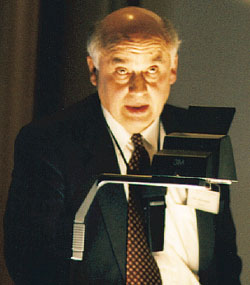Both theoretically and experimentally, spin physics has always been a challenge. Although many physicists proudly point to an increased understanding, some spin puzzles are still waiting for an explanation. The biennial Spin Physics Conference is always a good barometer for spin.


The series of biennial International Symposia on High Energy Spin Physics was initiated in 1974 and, in his opening talk at the recent meeting (the 13th in the series) at the Institute for High Energy Physics, Protvino, Russia, International Committee chairman Charles Prescott pointed out that the symposium venues have established a right-handed rotation about the world axis.
Last year marked the tenth anniversary of the European Muon Collaboration’s publication, which launched the nucleon spin problem the spin of the proton is not the sum of the spins of its individual quarks. E Gabathuler (Liverpool) gave an overview of recent experimental progress. The latest nucleon spin structure measurements were reported by I Savin (SMC, CERN), E Hughes (E155, SLAC, Stanford) and A Bruell (HERMES, DESY, Hamburg).
Progress in this sector means collecting data at smaller Bjorken x (momentum fraction carried by the struck quark) and increased statistical precision. The new high-precision experimental data for the proton and deuteron spin structure functions are consistent with previous measurements and allow better extrapolation to x = 0.
The small-x behaviour of the structure is one of the unsolved problems en route to a final resolution of the overall nucleon spin puzzle. Others are the important issues of gluon and sea quark contributions to the nucleon spin,
and the role of orbital angular momentum.
It is not easy to define the separate components of the nucleon spin in an interacting field theory of quarks and gluons. Different theoretical approaches to the nucleon spin problem in quantum chromodynamics (QCD) are related, to a large extent, to the renormalization and the role of the axial anomaly. These general theoretical problems and recent results were covered by V Petrov (Protvino).
After 10 years, explaining nucleon spin structure remains a problem. A solution could be expected from non perturbative QCD (for example, lattice calculations). Another possibility, advocated by T P Cheng (Missouri), is a two-stage approach where the first stage uses effective degrees of freedom at large distances (constituent quarks) and in the second stage these effective degrees of freedom are related to the QCD quarks and gluons. Experimentally, the constituent quark idea can be tested by measuring the strange quark content of the proton via parity-violating processes in high-energy electron scattering. Preliminary results from HAPPEX at Jefferson were reported by E Burtin (CEA-DSM/DAPNIA).
The theoretical status of spin effects in hard hadronic reactions was discussed by P Ratcliffe (Milan), while the current experimental results were covered by A Bravar (Mainz). Large spin asymmetries at the level of 30% were reported in inclusive meson and hyperon production. The asymmetries in different reactions have a similar dependence on transverse momentum and Feynman x and tend not to decrease with transverse momentum. However, elastic protonproton scattering shows increasing such behaviour with increasing transverse momentum.
After G Fidecaro of CERN related the early history of spin experiments, A Penzo (Trieste) surveyed future perspectives for such studies and their role in the resolution of current problems. A key player will be the spin experimental programme at Brookhaven’s RHIC collider, described by S Vigdor (Indiana). New physics opportunities at HERA with polarized protons were covered by A De Roeck (DESY), using material from a recent workshop. Perspectives for future experiments depend strongly on the progress in acceleration of polarized beams, and the availability of new polarized targets and sources.
In his plenary talk, A Masaike (KEK) described the role of spin as a probe of symmetry in intermediate and low-energy regions. H Ejiri (Osaka) reviewed the role of spin effects in neutrino-nuclear responses and nuclear medium effects. Reports on workshops sponsored by the International Committee were given by their organizers D Crabb (Virginia), A Efremov (Dubna) and Yu Mamaev (St Petersburg) and the meeting summary was given by A Krisch (Michigan).
Despite the enduring puzzles, the Protvino symposium displayed the considerable spin physics progress over the past two years. The next chapter in the story will be reported in Osaka, Japan, in 2000.
The local Protvino organizing committee received support from the International Committee, the Russian Ministry of Science and the Foundation for Basic Research. The proceedings are being published by World Scientific.





